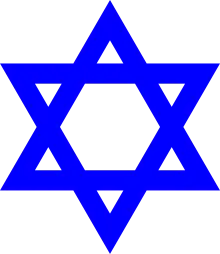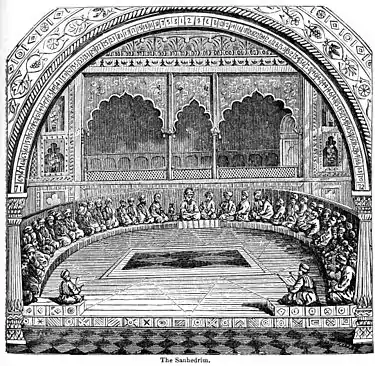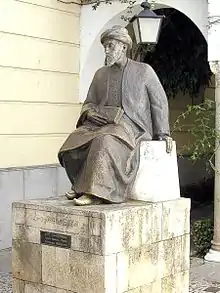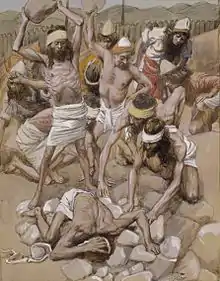Capital punishment in Judaism
Capital punishment in traditional Jewish law has been defined in Codes of Jewish law dating back to medieval times, based on a system of oral laws contained in the Babylonian and Jerusalem Talmud, the primary source being the Hebrew Bible. In traditional Jewish law there are four types of capital punishment: a) stoning, b) burning, c) strangling, and d) beheading, each of which being the punishment for specific offences. Except in special cases where a king can issue the death penalty, capital punishment in Jewish law cannot be decreed upon a person unless there were a minimum of twenty-three judges (Sanhedrin) adjudicating in that person's trial who, by a majority vote, gave the death sentence, and where there had been at least two competent witnesses who testified before the court that they had seen the litigant commit the capital offence. Even so, capital punishment does not begin in Jewish law until the court adjudicating in this case had issued the death sentence from a specific place (formerly, the Chamber of Hewn Stone) on the Temple Mount in the city of Jerusalem.[1]
| Part of a series on |
| Jews and Judaism |
|---|
 |
|

History
Capital and corporal punishment in Judaism has a complex history which has been a subject of extensive debate. The Bible and the Talmud specify capital punishment by the "Four Executions of the Court," — stoning, burning, decapitation, and strangulation — for the most severe transgressions,[2] and the corporal punishment of flagellation for intentional transgressions of negative commandments that do not incur one of the Four Executions. According to Talmudic law, the authority to apply capital punishment ceased with the destruction of the Second Temple.[2][3] The Mishnah states that a Sanhedrin that executes one person in seven years — or seventy years, according to Eleazar ben Azariah — is considered bloodthirsty.[4][5] During the Late Antiquity, the tendency of not applying the death penalty at all became predominant in Jewish courts.[6] In practice, where medieval Jewish courts had the power to pass and execute death sentences, they continued to do so for particularly grave offenses, although not necessarily the ones defined by the law.[2] While it was recognized that the use of capital punishment in the post-Second Temple era went beyond the biblical warrant, the rabbis who supported it believed that it could be justified by other considerations of Jewish law.[7][8] Whether Jewish communities ever practiced capital punishment according to rabbinical law, and whether the rabbis of the Talmudic era ever supported its use even in theory, has been a subject of historical and ideological debate.[9]
The 12th-century Jewish legal scholar Maimonides stated that "It is better and more satisfactory to acquit a thousand guilty persons than to put a single innocent one to death."[10] Maimonides argued that executing a defendant on anything less than absolute certainty would lead to a slippery slope of decreasing burdens of proof, until convictions would be merely "according to the judge's caprice". Maimonides was concerned about the need for the law to guard itself in public perceptions, to preserve its majesty and retain the people's respect.[11]
The position of Jewish Law on capital punishment often formed the basis of deliberations by Israel's Supreme Court. It has been carried out by Israel's judicial system only twice, in the cases of Adolf Eichmann[8] and Meir Tobianski.
Capital punishment in classical sources
In the Pentateuch
The institution of capital punishment in Jewish law is defined in the Law of Moses (Torah) in multiple places. The Mosaic Law provides for the death penalty to be inflicted upon those persons convicted of the following offences:
- adultery (for a married women)[lower-alpha 1] (Leviticus 20:10;Deuteronomy 22:22);[12]
- bestiality (Exodus 22:18; Leviticus 20:15);
- blasphemy (Leviticus 24:16);
- premarital sex (for girls) (Deuteronomy 22:13–21);[12][13]
- false testimony in capital cases (Deuteronomy 19:16–19);
- false prophecy (Deuteronomy 13:6, Deuteronomy 18:20);
- homosexual relations (Leviticus 18:22, Leviticus 20:13)
- idolatry, actual or virtual (Leviticus 20:2, Deuteronomy 13:7–19, Deuteronomy 17:2–7);
- incestuous or unnatural connections (Leviticus 18:22, Leviticus 20:11–14);
- insubordination to supreme authority (Deuteronomy 17:12);
- kidnaping (Exodus 21:16, Deuteronomy 24:7);
- licentiousness of a priest's daughter (Leviticus 21:9);
- murder (Exodus 21:12, Leviticus 24:17, Numbers 35:16, et seq.);
- Proselytizing and promoting other religions (Leviticus 13:7);
- rape committed on a betrothed woman[lower-alpha 2](Deuteronomy 22:25–27);
- striking, cursing, or otherwise rebelling against parental authority (Exodus 21:15, 17, Leviticus 20:9,Deuteronomy 21:18–21);
- Sabbath-breaking (Exodus 31:14, Exodus 35:2, Numbers 15:32–36);
- Touching Mount Sinai while God was giving Moses the Ten Commandments (Exodus 19:13);
- witchcraft, divination, necromancy, sorcery, etc. (Exodus 22:17, Leviticus 20:27).[14]
Modes of punishment
The court had power to inflict four kinds of death-penalty: stoning, burning, beheading, and strangling.[15]
Death by burning was issued in ten cases, among which being a bigamous marriage with a wife's mother and the prostitution of a priest's wedded daughter.[16] Perpetrators were not burnt at the stake, but rather molten lead was poured down the perpetrator's esophagus. Death by the sword was issued in two cases: for wanton murder and for communal apostasy (idolatry).[16] The perpetrators of these crimes were beheaded. Death by stoning was issued for the transgression of one of eighteen crimes, among which being those who wantonly transgressed the Sabbath-day by breaking its laws (excluding those who may have broken the Sabbath laws unintentionally), as well as a male who had a licentious connexion with another male.[16] Stoning was administered by pushing the bound, convicted criminal over the side of a building, so that he fell down and died upon impact with the ground. Death by strangulation was the punishment for six crimes, among which being a man who had a forbidden connexion with another man's wife (adultery), and a person who willfully caused injury (bruise) to one of his parents.[17]

Only in comparatively few instances is the particular mode of death incurred by the commission of a crime prescribed. Blasphemy, idolatry, Sabbath-breaking, witchcraft, prostitution by a betrothed virgin, or deceiving her husband at marriage as to her chastity (Deut. xxii. 21), and the rebellious son are, according to the Pentateuchal laws, to be punished with death by stoning; bigamous marriage with a wife's mother and the prostitution of a priest's daughter are punished by burning; communal apostasy is punished by the sword. With reference to all other capital offenses, the law ordains that the perpetrator shall die a violent death, occasionally adding the expression, "His (their) blood shall be upon him (them)." This expression applies to death by stoning. The Bible speaks also of hanging (Deut. xxi. 22), but, according to the rabbinical interpretation, not as a mode of execution, but, rather, of exposure after death (Sanh. vi. 4, 75b).[17]
In Rabbinic Judaism

The principal tractate in the Talmud that deals with such cases is Tractate Sanhedrin.
Cases concerning offences punishable by death are decided by 23 judges.[18] The reason for this odd number is that the early rabbis had learnt that it takes at least 10 judges to convict a man, and another 10 judges to acquit a man, and the court being unequal will result in a verdict rendered by majority vote.[19] Strict regulations were in place as to how these judges were to be selected, based on their sex, age and family standing. For example, they could not appoint a judge who did not have children of his own, for he was thought to be less merciful towards other men's children.[20] Nor could they select a judge who was not a male, for fear of the levity of the other sex.
The harshness of the death penalty indicated the seriousness of the crime. Jewish philosophers argue that the whole point of corporal punishment was to serve as a reminder to the community of the severe nature of certain acts. This is why, in Jewish law, the death penalty is more of a principle than a practice. The numerous references to a death penalty in the Torah underscore the severity of the sin, rather than the expectation of death. This is bolstered by the standards of proof required for application of the death penalty, which has always been extremely stringent (Babylonian Talmud Makkoth 7b). The Mishnah (tractate Makkoth 1:10) outlines the views of several prominent first-century CE rabbis on the subject:
"A Sanhedrin that puts a man to death once in seven years is called a murderous one. Rabbi Eliezer ben Azariah said, 'Or even once in 70 years.' Rabbi Tarfon and Rabbi Akiba said, 'If we had been in the Sanhedrin, no death sentence would ever have been passed'; Rabban Simeon ben Gamaliel said, 'If so, they would have multiplied murderers in Israel.'"[21]
The Talmud notes that "forty years before the destruction of the [Second] Temple, capital punishment ceased in Israel."[22] This date is traditionally put at 28 CE, a time that corresponds with the 18th year of Tiberius' reign. At this time, the Sanhedrin required the approbation of the Roman procurator of Judea before they could punish any malefactor by death. Other sources, such as Josephus, disagree. The issue is highly debated because of the relevancy to the New Testament trial of Jesus.[23][24] Ancient rabbis did not like the idea of capital punishment, and interpreted the texts in a way that made the death penalty virtually non-existent.
Legal proceedings involving capital punishment were to be handled with extreme caution. In all cases of capital punishment in Jewish law, the judges are required to open their deliberations by pointing out the good qualities of the litigant and to bring up arguments why he should be acquitted.[25][26] Only later did they hear the incriminating evidence. It was almost impossible to inflict the death penalty because the standards of proof were so high. As a result, convictions for capital offense were rare in Judaism.[27][28] The standards of evidence in capital cases include:
- It requires two witnesses who observed the crime. The accused would have been given a chance, and if s/he repeated the same crime, or any other, it would lead to a death sentence. If witnesses had been caught lying about the crime, they would be executed.
- Two witnesses were required. Acceptability was limited to:
- Adult Jewish men who were known to keep the commandments, knew the written and oral law, and had legitimate professions;
- The witnesses had to see each other at the time of the sin;
- The witnesses had to be able to speak clearly, without any speech impediment or hearing deficit (to ensure that the warning and the response were done);
- The witnesses could not be related to each other, or to the accused.
- The witnesses had to see each other, and both of them had to give a warning (hatra'ah) to the person that the sin they were about to commit was a capital offense;[29]
- This warning had to be delivered within seconds of the performance of the sin (in the time it took to say, "Peace unto you, my Rabbi and my Master");
- In the same amount of time, the person about to sin had to both respond that s/he was familiar with the punishment, but they were going to sin anyway; and begin to commit the sin/crime;
- The Beth Din (rabbinical court) had to examine each witness separately; and if even one point of their evidence was contradictory - even if a very minor point, such as eye color - the evidence was considered contradictory, and the evidence was not heeded;
- The Beth Din had to consist of minimally 23 judges;
- The majority could not be a simple majority - the split verdict that would allow conviction had to be at least 13 to 11 in favor of conviction;
- If the Beth Din arrived at a unanimous verdict of guilty, the person was let go - the idea being that if no judge could find anything exculpatory about the accused, there was something wrong with the court.[30]
- The witnesses were appointed by the court to be the executioners.
Where the death sentence was warranted but the court had not the jurisdiction to mete out the death sentence, such as when there were not two or more witnesses, the court had the authority to lock-up the convicted individual within a cupola, or similar confined structure, and to feed him meager portions of bread and water until he dies.[31]
Megillat Taanit
According to an oral treaching alluded to in the now obsolete Megillath Taanit ("Scroll of Fasting"), the four modes of execution formerly used in Jewish law were mostly orally transmitted practices not explicitly stated in the Written Law of Moses, although some modes of punishment are explicitly stated. Megillat Taanit notes that "On the fourteenth [day] of [the lunar month] Tammuz, the book of decrees had been purged" (בארבעה עשר בתמוז עדא ספר גזרתא), explained as meaning on the 4th day of the lunar month Tammuz, a book of decrees relayed by the Sadducees and the Boethusians had been taken away, who would, in all cases, show proof from a written text concerning the four modes of capital punishment, rather than from an orally transmitted tradition and which tradition had previously prevailed and been received by the people, as evinced by the Pharisees.[32][33] The vindication of the Pharisees over the Sadducees and Boethusians gave rise to this date being held in honor, until the Scroll of Fasting was cancelled altogether.
Capital sins separated by the four types of capital punishment

The following is a list by Maimonides in his Mishneh Torah (Hilchoth Sanhedrin Chapter 15) of which crimes carry a capital punishment.
Punishment by skila (סקילה, stoning)

- Intercourse between a man and his mother.
- Intercourse between a man and his father's wife (not necessarily his mother).
- Intercourse between a man and his daughter in law.
- Intercourse with another man's wife from the first stage of marriage.
- Intercourse between two men.
- Bestiality.
- Cursing the name of God in God's name.
- Idol worship.
- Giving one's progeny to Molech (child sacrifice).
- Necromancy sorcery.
- Pythonic sorcery.
- Attempting to convince another to worship idols.
- Instigating a community to worship idols.
- Witchcraft.
- Violating the Sabbath.
- Cursing one's own parent.
- A stubborn and rebellious son.
Punishment by serefah (שריפה, burning)
According to Halakha, this punishment is conducted by pouring molten metal (lead, or a mixture of lead and tin) into one's throat, rather than burning at the stake.
- The daughter of a priest who completed the second stage of marriage commits adultery.
- Intercourse between a man and his daughter.
- Intercourse between a man and his daughter's daughter.
- Intercourse between a man and his son's daughter.
- Intercourse between a man and his wife's daughter (not necessarily his own daughter).
- Intercourse between a man and his wife's daughter's daughter.
- Intercourse between a man and his wife's son's daughter.
- Intercourse between a man and his mother in law.
- Intercourse between a man and his mother in law's mother.
- Intercourse between a man and his father in law's mother.
Punishment by hereg (הרג, beheading by sword)
- Unlawful premeditated murder.
- Being a citizen of a city that has gone astray.
Punishment by chenek (חנק, strangulation)
- Committing adultery with another man's wife, when it does not fall under the above criteria.
- Wounding one's own parent.
- Kidnapping another Israelite.
- Prophesying falsely.
- Prophesying in the name of other deities.
- A sage who is guilty of insubordination in front of the grand court in the Chamber of the Hewn Stone.
Contemporary attitudes towards capital punishment
Rabbinical courts have given up the ability to inflict any kind of physical punishment, and such punishments are left to the civil court system to administer. The modern institution of the death penalty, at least as practiced in the United States, is opposed by the major rabbinical organizations of Orthodox, Conservative, and Reform Judaism.[34][35]
Orthodox Judaism
Orthodox Rabbi Aryeh Kaplan wrote:
"In practice, ... these punishments were almost never invoked, and existed mainly as a deterrent and to indicate the seriousness of the sins for which they were prescribed. The rules of evidence and other safeguards that the Torah provides to protect the accused made it all but impossible to actually invoke these penalties ... the system of judicial punishments could become brutal and barbaric unless administered in an atmosphere of the highest morality and piety. When these standards declined among the Jewish people, the Sanhedrin ... voluntarily abolished this system of penalties.[36]
On the other hand, Rabbi Moshe Feinstein, in a letter to then-New York Governor Hugh Carey,[37] states: "One who murders because the prohibition to kill is meaningless to him, and he is especially cruel, and so too when murderers and evil people proliferate, they [the courts] would [should?] judge [capital punishment] to repair the issue [and] to prevent murder – for this [action of the court] saves the state."
Conservative Judaism
In Conservative Judaism, the death penalty was the subject of a responsum by its Committee on Jewish Law and Standards, which has gone on record as opposing the modern institution of the death penalty:
"The Talmud ruled out the admissibility of circumstantial evidence in cases which involved a capital crime. Two witnesses were required to testify that they saw the action with their own eyes. A man could not be found guilty of a capital crime through his own confession or through the testimony of immediate members of his family. The rabbis demanded a condition of cool premeditation in the act of crime before they would sanction the death penalty; the specific test on which they insisted was that the criminal be warned prior to the crime, and that the criminal indicate by responding to the warning, that he is fully aware of his deed, but that he is determined to go through with it. In effect, this did away with the application of the death penalty. The rabbis were aware of this, and they declared openly that they found capital punishment repugnant to them… There is another reason which argues for the abolition of capital punishment. It is the fact of human fallibility. Too often, we learn of people who were convicted of crimes, and only later are new facts uncovered by which their innocence is established. The doors of the jail can be opened; in such cases, we can partially undo the injustice. But the dead cannot be brought back to life again. We regard all forms of capital punishment as barbaric and obsolete."[38]
Reform Judaism
Since 1959, the Central Conference of American Rabbis and the Union for Reform Judaism have formally opposed the death penalty. The Central Conference also resolved in 1979 that "both in concept and in practice, Jewish tradition found capital punishment repugnant", and there is no persuasive evidence "that capital punishment serves as a deterrent to crime".[39]
See also
Notes
- Since polygamy is permitted, married men are not prohibited from relations with multiple women
- The next 2 verses state that for an unbetrothed girl, the rapist "pays the father fifty shekels of silver, and she shall be his wife"
References
- Jerusalem Talmud (Horayot 2a): "They do not make a person liable until such instruction comes forth from the Chamber of Hewn Stone. Said Rabbi Yohanan: The reason being is that there is a teaching that [explicitly] states, 'From that place which the Lord shall choose' (Deuteronomy 17:10)." Cf. Babylonian Talmud (Rosh Hashanah 31a–b; Avodah Zarah 8b), where the Sanhedrin intentionally removed themselves from the Chamber of Hewn Stone (לשכת הגזית) on the Temple Mount and sat in the Hanuth, and thence removed themselves to other places (known as the ten migratory journeys of the Sanhedrin) so that the court could not execute an offending Jew, since the 23 judges needed to condemn a man to die would formerly convene in the Temple Mount to decide on capital cases.
- Haim Hermann Cohn (2008). "Capital Punishment. In the Bible & Talmudic Law". Encyclopedia Judaica. The Gale Group.
- "[A]t a time when there is no priest [serving in the Temple], there is no judgment [of capital cases]." Sanh. 52b.
- Louis Isaac Rabinowitz (2008). "Capital Punishment. In Practice in the Talmud". Encyclopedia Judaica. The Gale Group.
Similarly, the passage in Mishnah Makkot 1:10: "A Sanhedrin that puts a man to death once in seven years is called a murderous one. R. Eleazar ben Azariah says, 'Or even once in 70 years.' R. Tarfon and R. Akiva said, 'If we had been in the Sanhedrin, no death sentence would ever have been passed'; Rabban Simeon b. Gamaliel said: 'If so, they would have multiplied murderers in Israel.'
- Menachem Elon (2008). "Capital Punishment. In the State of Israel". Encyclopedia Judaica. The Gale Group.
This refers to the statement in the Mishnah (Mak. 1:10; Mak. 7a) that a Sanhedrin that kills (gives the death penalty) once in seven years (R. Eleazer b. Azariah said: once in 70 years) is called "bloody" (ḥovlanit, the term "ḥovel" generally implying a type of injury in which there is blood).
- Glen Warren Bowersock, Peter Brown, Oleg Grabar (1999). Late Antiquity: A Guide to the Postclassical World. Harvard University Press. p. 400.CS1 maint: uses authors parameter (link)
- Dale S. Recinella (2015). The Biblical Truth about America's Death Penalty. Northeastern University Press. p. 93. ISBN 9781555538620.
- Menachem Elon (2008). "Capital Punishment. In the State of Israel". Encyclopedia Judaica. The Gale Group.
- Jacobs, Jill (2009). There Shall Be No Needy: Pursuing Social Justice Through Jewish Law & Tradition. Woodstock, Vt: Jewish Lights. p. 200. ISBN 9781580234252.
- Goldstein, Warren (2006). Defending the human spirit: Jewish law's vision for a moral society. Feldheim Publishers. p. 269. ISBN 978-1-58330-732-8. Retrieved 22 October 2010.
- Moses Maimonides, The Commandments, Neg. Comm. 290, at 269-271 (Charles B. Chavel trans., 1967).
- Weren, Wim J. C. (2012). "The Use of Violence in Punishing Adultery in Biblical Texts (Deuteronomy 22:13-29 and John 7:53-8:11)". In Villiers, Pieter G. R. de; Henten, Jan Willem van (eds.). Coping with Violence in the New Testament. BRILL. pp. 134–139. ISBN 978-90-04-22104-8.
- Gane, Roy (2001). "Old Testament Principles Relating to Divorce and Remarriage". Journal of the Adventist Theological Society: 44–45.
- Marcus Jastrow, Jewish Encyclopedia, s.v. Capital Punishment
- Mishnah Sanhedrin 7:4
- Marcus Jastrow, S. Mendelsohn, Jewish Encyclopedia, s.v. Capital Punishment
- Marcus Jastrow, S. Mendelsohn (1906). "Capital punishment". Jewish Encyclopedia.
- Mishnah Sanhedrin 1:4
- Babylonian Talmud (Sanhedrin 2a-b)
- Maimonides, Mishne Torah (Hil. Sanhedrin 2:3)
- Encyclopaedia Judaica. "Capital Punishment". The Gale Group. Retrieved 9 August 2016.
- Babylonian Talmud (Avodah Zarah 8b; Shabbat 15a); Jerusalem Talmud (Sanhedrin 1:1 [1b])
- https://www.jewishvirtuallibrary.org/jsource/judaica/ejud_0002_0004_0_03929.html
- Watson E. Mills; Roger Aubrey Bullard, eds. (1990). Mercer Dictionary of the Bible. Mercer University Press. p. 795. ISBN 9780865543737.
- Meiri (2006). Daniel Bitton (ed.). Beit HaBechirah (Chiddushei ha-Meiri) (in Hebrew). 7. Jerusalem: Hamaor Institute. p. 62. OCLC 181631040., s.v. Sanhedrin 32b, explaining Mishnah Sanhedrin 4:1
- Maimonides (1974). Sefer Mishneh Torah - HaYad Ha-Chazakah (Maimonides' Code of Jewish Law) (in Hebrew). 7. Jerusalem: Pe'er HaTorah. pp. 26 [13b], 32 [16b] (Hil. Sanhedrin 9:1, 12:3). OCLC 122758200.
- Mishnah Maccot, 1:10
- "讚讬谞讬 谞驻砖讜转". cet.ac.il.
- Maimonides (1974). Sefer Mishneh Torah - HaYad Ha-Chazakah (Maimonides' Code of Jewish Law) (in Hebrew). 7. Jerusalem: Pe'er HaTorah. p. 31 [16a] (Hil. Sanhedrin 12:2). OCLC 122758200.
- Babylonian Talmud, Tractate Sanhedrin, page 17a. Also Maimonides, Mishneh Torah, Sanhedrin, Chapter 9.
- Babylonian Talmud (Sanhedrin 81b)
- The Aramaic wording of this particular entry has given rise to much confusion. Some will translate the text: "On the 4th of Tammuz the book of decrees was removed (purged)" or else "On the 4th of Tammuz the book of decrees was cancelled." This translation has given rise to some who explain that the Sadducees had formerly possessed a book of decrees outlining which punishments are to be inflicted for the various offences and which thing was not permitted to have transcribed in writing, since the matter was wholly committed to oral tradition (Herzog College, s.v. The Scroll of Fasting (in Hebrew)
- Megillat Taanit, Fourth day of the lunar month Tammuz, Hemed Publishers
- "The Death Penalty in Jewish Tradition." My Jewish Learning. 20 January 2018
- Biale, Rachel. "The Death Penalty in Jewish Teachings." Bend the Arc. 4 October 2012. 2 November 2017.
- Rabbi Aryeh Kaplan. Handbook of Jewish Thought, Volume II, pp. 170-71
- Responsa Iggerot Moshe, Choshen Mishpat v. 2 responsum 68
- Bokser, Ben Zion. "Statement on capital punishment, 1960." Proceedings of the Committee on Jewish Law and Standards 1927-1970, Volume III, pp. 1537-1538.
- "Position of the Reform Movement on the Death Penalty". Religious Action Center.
Further reading
- Capital Punishment, Jewish Virtual Library
- The Death Penalty in Jewish Tradition
- Jewish Law Legal Briefs
- Berkowitz, Beth A. (2002). "Decapitation and the discourse of antisyncretism in the Babylonian Talmud". Journal of the American Academy of Religion. 70 (2): 743–770. doi:10.1093/jaar/70.4.743.
